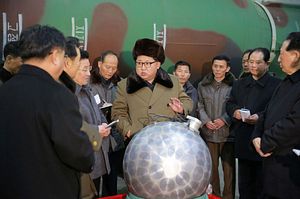The Diplomat has learned from U.S. government sources with access to a new U.S. Defense Intelligence Agency (DIA) assessment that North Korea may be accruing fissile material at a rate sufficient to add 12 nuclear weapons to its growing arsenal each year.
On Tuesday, the Washington Post first reported on the assessment, which details the state of North Korea’s nuclear and ballistic missile programs.
Among the updated findings, the DIA assessment estimates North Korea to be fully capable of manufacturing a compact nuclear weapon for mating with its large ballistic missiles — likely its Hwasong-14 intercontinental-range ballistic missile and Hwasong-12 intermediate range ballistic missile, but also possibly its Pukkuksong-series of solid-fuel missiles, which includes a submarine-launched missile.
U.S. government sources with knowledge of the DIA assessment who spoke separately to The Diplomat have confirmed the details reported by the Post, which also added that the U.S. intelligence community currently calculates that North Korea may potentially be in possession of enough fissile material for 60 nuclear weapons.
The Diplomat understands that the latest assessment of 60 weapons is an upper-bound estimate that was revised up from 40 weapons, which was current earlier this summer. The latest assessment is based on estimated ongoing uranium enrichment activity at various facilities across North Korea.
Sources have told The Diplomat that the DIA assesses North Korea, given its current uranium enrichment activities, is likely capable of generating an additional 12 weapons worth of fissile material a year.
The DIA assessment of 60 weapons assumes the use of composite pit core designs for nuclear bombs by North Korea; composite pits combine plutonium-239 and uranium highly enriched in uranium-235, the two fissile material isotopes suitable for nuclear bombs, to more efficiently design bombs.
In March 2016, North Korean state media released an image of Kim Jong-un with a device claimed to be a compact fission bomb. An accompanying statement noted a “Korean-style structure of mixed charge” in the design of the bomb, which some analysts interpreted as an allusion to a composite pit design.
Composite core designs for nuclear weapons were originally developed to bypass constraints on plutonium-239 supply. North Korea’s stockpile of plutonium is limited, but it is actively milling and enriching uranium for use in bombs; naturally occurring uranium, which is not fit for use in nuclear weapons without increasing the percentage composition of uranium-235, is thought to be abundant in North Korea.
Moreover, North Korea’s stockpile of plutonium may grow should it choose to recover fissionable plutonium from spent nuclear fuel from the Yongbyon Nuclear Scientific Research Center. Pyongyang has said that it would seek to produce more plutonium and is likely already doing so.
The U.S. intelligence community first suggested that North Korea may be capable of building a compact nuclear device as early as 2013, but at the time, that was a low confidence assessment. After both its January and September nuclear tests last year, North Korea claimed to have made important advances in reducing the size of its devices.
The physical size and weight of nuclear weapons matters for their effect on their suitability for different ballistic missiles and their effect on the maximum range of North Korea’s long-range missiles.
Physically larger payloads require a missile to have a greater diameter and require a larger reentry vehicle. Heavier payloads, meanwhile, require more energy to travel further; all other things being the same, any given North Korean missile design can travel further the lighter its weapons payload.

































